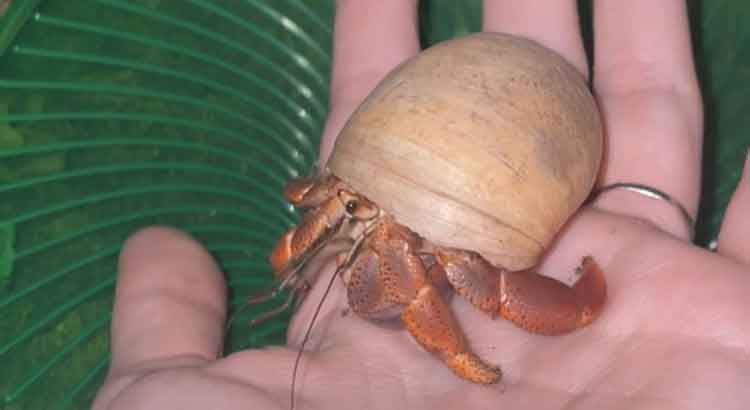Hermit crabs are adorable little creatures, but dealing with mites on them can be quite a hassle.
The safest way to rid your hermit crab of mites is by giving them a saltwater bath. Simply mix marine aquarium salt into water and let your crab soak for a few minutes. This method effectively kills mites without harming your pet.
Discovering the best methods for mite removal will not only ensure your hermit crab’s well-being but also give you peace of mind knowing your pet is safe and healthy. Keep reading to learn more about safely caring for your hermit crab.
Preventing Spread to Other Crabs
To prevent mites from spreading to other crabs, isolate the infected crab immediately. Place it in a separate tank with clean substrate and provide proper care. Regularly clean and disinfect the tank to eliminate any lingering mites. Keep a close eye on other crabs for signs of infestation.
Ensuring proper hygiene is crucial in preventing mite spread. Clean the tank and accessories regularly using a mixture of vinegar and water. Avoid overcrowding in the tank to reduce stress on the crabs, which can make them more susceptible to mites. With these simple steps, you can effectively safeguard your other crabs from mite infestations.
Removing Mite Infestations
For immediate mite removal, gently brush your crab with a soft toothbrush. This helps dislodge mites from the crab’s shell and legs. Follow up with a saltwater bath to further eliminate mites. Monitor your crab closely for any signs of recurring infestations and repeat the treatment if necessary.
In severe cases, consult a veterinarian specializing in exotic pets for guidance. They may recommend additional treatments or medications to eradicate mites completely. By taking prompt action and following these steps, you can effectively remove mites from your hermit crab and ensure its continued health and well-being.
Eliminating Mites on Shells
To eliminate mites on shells, remove the crab from its shell and inspect it carefully. Clean the shell with a soft brush and warm, soapy water to remove any mites and debris. Rinse thoroughly and allow the shell to air dry before placing the crab back inside.
Regularly inspecting and cleaning shells is essential for preventing mite infestations. Ensure shells are properly sized for your crab and provide a variety of options for them to choose from. This encourages them to switch shells regularly, reducing the risk of mites establishing a foothold on one shell.
Maintaining Hygiene
Maintaining a clean environment is crucial for preventing mite infestations. Regularly clean and disinfect the tank, accessories, and substrate. Remove any uneaten food promptly to prevent mold growth, which can attract mites. Additionally, provide fresh water and food to keep your hermit crab healthy and happy. Regular maintenance is key to keeping mites at bay and ensuring your crab’s well-being.
FAQ
Q: How do I know if my hermit crab has mites?
A: Look for signs such as tiny moving specks on the crab’s shell, especially around joints and under the abdomen. Additionally, observe your crab for excessive scratching or agitation, which may indicate mite infestation.
Q: Can mites harm my hermit crab?
A: Yes, mites can cause irritation, stress, and even transmit diseases to your hermit crab. If left untreated, severe infestations can lead to health problems and even death in extreme cases.
Q: How often should I clean my hermit crab’s habitat to prevent mites?
A: Clean the tank and accessories regularly, aiming for at least once a week. Spot clean as needed to remove any uneaten food or waste. Regular maintenance helps prevent mites and keeps your crab’s habitat clean and healthy.
Q: Can I use over-the-counter mite treatments for my hermit crab?
A: It’s not recommended to use over-the-counter mite treatments without consulting a veterinarian first. Some treatments may be harmful to hermit crabs or ineffective against certain types of mites. Always seek professional advice before using any medication.
Q: How long does it take to get rid of mites on my hermit crab?
A: The timeline for eliminating mites can vary depending on the severity of the infestation and the effectiveness of the treatment. In some cases, it may take several weeks of consistent treatment and monitoring to completely eradicate mites.
Q: Can I prevent mites from returning after treatment?
A: Yes, maintaining good hygiene practices is key to preventing mites from returning. Regularly clean and disinfect the tank, accessories, and substrate. Monitor your crab closely for any signs of mites and take prompt action if necessary.
Final Thoughts
Taking care of your hermit crab’s health and well-being is a rewarding responsibility. By staying vigilant for signs of mites and implementing proper prevention and treatment methods, you can ensure a happy and thriving crab. Remember to regularly inspect your crab’s shell and habitat, and take prompt action if you suspect a mite infestation. With patience and dedication, you can effectively manage and prevent mite problems, providing your hermit crab with a comfortable and safe environment to flourish.
It’s essential to educate yourself about hermit crab care and mite management to make informed decisions for your pet’s health. Utilize reputable resources such as veterinary websites, care guides, and forums to expand your knowledge and stay up-to-date on best practices. Additionally, don’t hesitate to reach out to experienced hermit crab owners or exotic pet veterinarians for advice and support. Building a strong support network can help you navigate any challenges that arise and ensure the well-being of your beloved hermit crab.
Ultimately, the bond between you and your hermit crab is a special one that requires dedication and care. By prioritizing your crab’s health and taking proactive measures to prevent and manage mite infestations, you can enjoy many happy years together. Remember to observe your crab’s behavior closely, provide a stimulating environment, and shower them with love and attention. With proper care and attention, you can create a fulfilling and enriching life for your cherished hermit crab companion.

